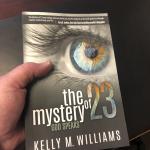Isaiah 63 begins with a question: Who is this? He comes from the direction of Edom, his clothing is stained (the Heb. verb is chametz, “leavened”. Yahweh answer: “I speaker of righteousness, mighty to save” (v. 1; Heb. for last phrase rab lehoshiy’a). Verse 2 asks another question: Why the stained clothes? Yahweh answers in parallel verses: A. I was alone B. I trod and trampled in anger C. I am stained with juice. A’. There was no one to... Read more




















